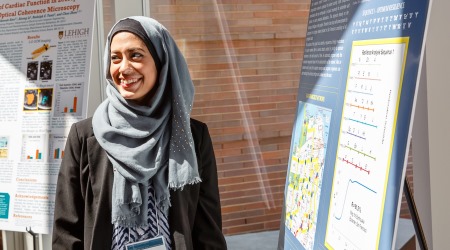Ms. Heba Elsayed worked as undergraduate researcher in Dr. Bocchini's group for several years and she has been admitted to some of the best master programs in the Nation.
[September 2015]
Ms. Heba Elsayed first met Dr. Bocchini when he was her instructor for the sophomore course Strength of Materials. At the end of the course she manifested interest in exploring extra-curricular aspects of Civil Engineering and started doing research under the supervision of Dr. Bocchini soon after. Heba worked in the field of seismic resilience of transportation networks, a line of research that would eventually be the root of the PRAISys project. A large part of the research community has promoted a shift of focus that led to the incorporation of the disaster recovery phase in engineering analyses. Several studies have proved that the long-term utility losses and recovery costs overwhelm instantaneous and short-term economic losses in case of earthquakes and other disasters. These analyses are meaningful only if performed at the community scale, and they tend to be highly inter-disciplinary, involving structural engineering, transportation modeling, probabilistic analysis, optimization, construction management, and cost estimation. It is easy to understand that this may seem an overwhelming topic for a sophomore student, with obviously limited background and experience. Nevertheless, Heba was not intimidated by the task and she joined Dr. Bocchini's research group with strong enthusiasm and passion. She leveraged the previous expertise of the group; she learned how to use our commercial and in-house-developed software, as well as various computational resources; she also addressed since the beginning a specific aspect independently. Her focus was to understand how the previous works of the team on large highway networks could be adapted and applied to urban road networks. She first performed an exhaustive data collection on the City of San Francisco, exploiting multiple sources, including the National Bridge Inventory and the HAZUS-MH database, among others. Then, she converted these data in formats adequate for regional fragility analysis and network resilience assessment. Subsequently she tested the previous approach of the team, and she could confirm that some of the performance metrics that the team used for the optimal restoration of seismically damaged highway bridges are not appropriate for urban networks, even though others are still valid. Therefore, Heba worked on innovative resilience metrics specifically tailored to urban transportation networks, and on how these can be integrated in a general disaster management framework for the optimization of the network resilience.
Despite the complex and mutifaceted topic, Heba’s willingness to succeed and dedication have been a major factor in leading to the positive outcome of her research. In fact, Heba represented the Civil Engineering major in Lehigh University’s annual Undergraduate Research Symposium, with a poster entitled “Seismic Resilience of Transportation Networks” during her junior year. She prepared the poster and presented it to the faculty and students who visited the symposium. Moreover, every year the Lehigh Valley Chapter of the ASCE organizes an event where a few selected undergraduate students from the universities of the region deliver a speech about their research. As a junior, Heba gave a presentation with title “Seismic Resilience of Bridges and Transportation Networks: Application to San Francisco”.
As expected, Heba's passion made her want to complete her education with graduate studies. With the guidance of Dr. Bocchini and the other faculty of the department, she applied to some of the best graduate programs in the Nation, and she was admitted to graduate programs at Lehigh, Columbia, and Georgia Tech. She chose the latter and started a Master in Civil Engineering, after graduating from Lehigh.
If you want to follow Heba's example, consider joining our team.
Useful links
- Probabilistic Resilience Assessment of Interdependent System (PRAISys): www.praisys.org
- Heba Elsayed's LinkedIn page: https://www.linkedin.com/in/heba-elsayed-424195105/
